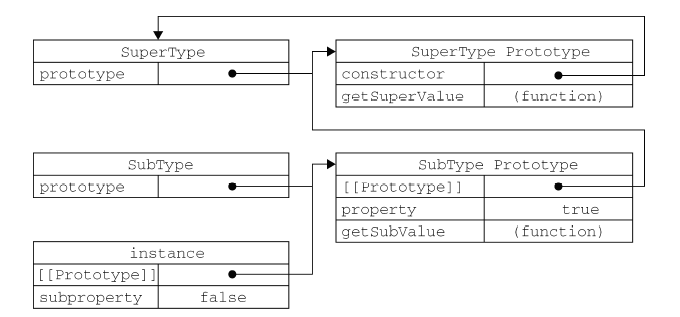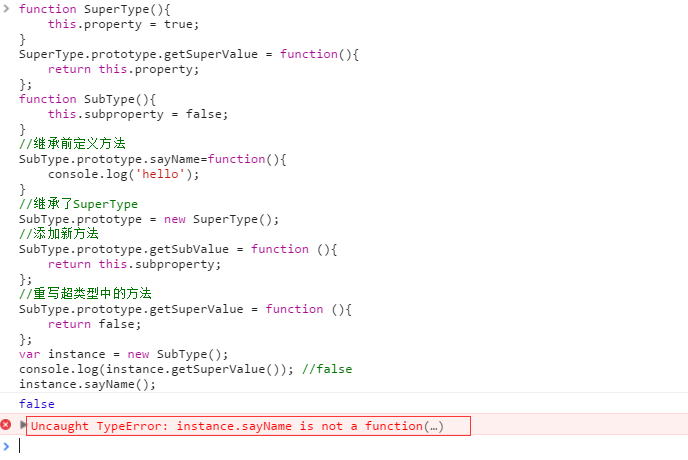<!DOCTYPE html>
<html>
<head>
<meta charset="UTF-8">
<title></title>
<script type="text/javascript">
function MAN(name, sex, age) {
this.name = name;
this.sex = sex;
this.age = age;
this.say = function(school,zhuanye) {
console.log(this.name + " , " + this.sex + " ,今年" + this.age+"岁!在"+school+"学习"+zhuanye);
}
}
function WOMAN(name, sex, age) {
this.name = name;
this.sex = sex;
this.age = age;
}
var man=new MAN("张三","男",26);
var woman=new WOMAN("小红","女",18);
man.say('清华大学','挖掘机');
man.say.call(woman,"蓝翔技校","电气焊");
man.say.apply(woman,["新东方","火星语"]);
man.say.bind(woman)("德云社","流行音乐");
</script>
</head>
<body>
</body>
</html>
js继承有5种实现方式:
1、继承第一种方式:对象冒充
function Parent(username){
this.username = username;
this.hello = function(){
alert(this.username);
}
}
function Child(username,password){
//通过以下3行实现将Parent的属性和方法追加到Child中,从而实现继承
//第一步:this.method是作为一个临时的属性,并且指向Parent所指向的对象,
//第二步:执行this.method方法,即执行Parent所指向的对象函数
//第三步:销毁this.method属性,即此时Child就已经拥有了Parent的所有属性和方法
this.method = Parent;
this.method(username);//最关键的一行
delete this.method;
this.password = password;
this.world = function(){
alert(this.password);
}
}
var parent = new Parent("zhangsan");
var child = new Child("lisi","123456");
parent.hello();
child.hello();
child.world();
2、继承第二种方式:call()方法方式
call方法是Function类中的方法
call方法的第一个参数的值赋值给类(即方法)中出现的this
call方法的第二个参数开始依次赋值给类(即方法)所接受的参数
function test(str){
alert(this.name + " " + str);
}
var object = new Object();
object.name = "zhangsan";
test.call(object,"langsin");//此时,第一个参数值object传递给了test类(即方法)中出现的this,而第二个参数"langsin"则赋值给了test类(即方法)的str
function Parent(username){
this.username = username;
this.hello = function(){
alert(this.username);
}
}
function Child(username,password){
Parent.call(this,username);
this.password = password;
this.world = function(){
alert(this.password);
}
}
var parent = new Parent("zhangsan");
var child = new Child("lisi","123456");
parent.hello();
child.hello();
child.world();
3、继承的第三种方式:apply()方法方式
apply方法接受2个参数,
A、第一个参数与call方法的第一个参数一样,即赋值给类(即方法)中出现的this
B、第二个参数为数组类型,这个数组中的每个元素依次赋值给类(即方法)所接受的参数
function Parent(username){
this.username = username;
this.hello = function(){
alert(this.username);
}
}
function Child(username,password){
Parent.apply(this,new Array(username));
this.password = password;
this.world = function(){
alert(this.password);
}
}
var parent = new Parent("zhangsan");
var child = new Child("lisi","123456");
parent.hello();
child.hello();
child.world();
4、继承的第四种方式:原型链方式,即子类通过prototype将所有在父类中通过prototype追加的属性和方法都追加到Child,从而实现了继承
function Person(){
}
Person.prototype.hello = "hello";
Person.prototype.sayHello = function(){
alert(this.hello);
}
function Child(){
}
Child.prototype = new Person();//这行的作用是:将Parent中将所有通过prototype追加的属性和方法都追加到Child,从而实现了继承
Child.prototype.world = "world";
Child.prototype.sayWorld = function(){
alert(this.world);
}
var c = new Child();
c.sayHello();
c.sayWorld();
5、继承的第五种方式:混合方式
混合了call方式、原型链方式
function Parent(hello){
this.hello = hello;
}
Parent.prototype.sayHello = function(){
alert(this.hello);
}
function Child(hello,world){
Parent.call(this,hello);//将父类的属性继承过来
this.world = world;//新增一些属性
}
Child.prototype = new Parent();//将父类的方法继承过来
Child.prototype.sayWorld = function(){//新增一些方法
alert(this.world);
}
var c = new Child("zhangsan","lisi");
c.sayHello();
c.sayWorld();
JS继承之借用构造函数继承和组合继承
根据少一点套路,多一点真诚这个原则,继续学习。
借用构造函数继承
在解决原型中包含引用类型值所带来问题的过程中,开发人员开始使用一种叫做借用构造函数
(constructor stealing)的技术(有时候也叫做伪造对象或经典继承)。这种技术的基本思想相当简单,即
在子类型构造函数的内部调用超类型构造函数。
基本模式
|
1
2
3
4
5
6
7
8
9
10
11
12
|
function
SuperType(){
this
.colors = [
"red"
,
"blue"
,
"green"
];
}
function
SubType(){
//继承了SuperType
SuperType.call(
this
);
}
var
instance1 =
new
SubType();
instance1.colors.push(
"black"
);
alert(instance1.colors);
//"red,blue,green,black"
var
instance2 =
new
SubType();
alert(instance2.colors);
//"red,blue,green"
|
基本思想
借用构造函数的基本思想就是利用call或者apply把父类中通过this指定的属性和方法复制(借用)到子类创建的实例中。因为this对象是在运行时基于函数的执行环境绑定的。也就是说,在全局中,this等于window,而当函数被作为某个对象的方法调用时,this等于那个对象。call 、apply方法可以用来代替另一个对象调用一个方法。call、apply 方法可将一个函数的对象上下文从初始的上下文改变为由 thisObj 指定的新对象。
所以,这个借用构造函数就是,new对象的时候(注意,new操作符与直接调用是不同的,以函数的方式直接调用的时候,this指向window,new创建的时候,this指向创建的这个实例),创建了一个新的实例对象,并且执行SubType里面的代码,而SubType里面用call调用了SuperTyep,也就是说把this指向改成了指向新的实例,所以就会把SuperType里面的this相关属性和方法赋值到新的实例上,而不是赋值到SupType上面。所有实例中就拥有了父类定义的这些this的属性和方法。
优势
相对于原型链而言,借用构造函数有一个很大的优势,即可以在子类型构造函数中向超类型构造函数传递参数。因为属性是绑定到this上面的,所以调用的时候才赋到相应的实例中,各个实例的值就不会互相影响了。
例如:
function SuperType(name){
this.name = name;
}
function SubType(){
//继承了SuperType,同时还传递了参数
SuperType.call(this, "Nicholas");
//实例属性
this.age = 29;
}
var instance = new SubType();
alert(instance.name); //"Nicholas";
alert(instance.age); //29
劣势
如果仅仅是借用构造函数,那么也将无法避免构造函数模式存在的问题——方法都在构造函数中定义,因此函数复用就无从谈起了。而且,在超类型的原型中定义的方法,对子类型而言也是不可见的,结果所有类型都只能使用构造函数模式。考虑到这些问题,借用构造函数的技术也是很少单独使用的。
组合继承
组合继承(combination inheritance),有时候也叫做伪经典继承。是将原型链和借用构造函数的技术组合到一块,从而发挥二者之长的一种继承模式。
基本思想
思路是使用原型链实现对原型属性和方法的继承,而通过借用构造函数来实现对实例属性的继承。这样,既通过在原型上定义方法实现了函数复用,又能够保证每个实例都有它自己的属性。
基本模型
|
1
2
3
4
5
6
7
8
9
10
11
12
13
14
15
16
17
18
19
20
21
22
23
24
25
26
27
|
function
SuperType(name){
this
.name = name;
this
.colors = [
"red"
,
"blue"
,
"green"
];
}
SuperType.prototype.sayName =
function
(){
alert(
this
.name);
};
function
SubType(name, age){
//继承属性
SuperType.call(
this
, name);
this
.age = age;
}
//继承方法
SubType.prototype =
new
SuperType();
SubType.prototype.constructor = SubType;
SubType.prototype.sayAge =
function
(){
alert(
this
.age);
};
var
instance1 =
new
SubType(
"Nicholas"
, 29);
instance1.colors.push(
"black"
);
alert(instance1.colors);
//"red,blue,green,black"
instance1.sayName();
//"Nicholas";
instance1.sayAge();
//29
var
instance2 =
new
SubType(
"Greg"
, 27);
alert(instance2.colors);
//"red,blue,green"
instance2.sayName();
//"Greg";
instance2.sayAge();
//27
|
优势
组合继承避免了原型链和借用构造函数的缺陷,融合了它们的优点,成为JavaScript 中最常用的继承模式。
劣势
组合继承最大的问题就是无论什么情况下,都会调用两次超类型构造函数:一次是在创建子类型原型的时候,另一次是在子类型构造函数内部。虽然子类型最终会包含超类型对象的全部实例属性,但我们不得不在调用子类型构造函数时重写这些属性。
To be continued...
JS继承之原型继承
许多OO语言都支持两种继承方式:接口继承和实现继承。接口继承只继承方法签名,而实现继承则继承实际的方法。如前所述,由于函数没有签名,在ECMAScript中无法实现接口继承。ECMAScript只支持实现继承,而且其实现继承主要是依靠原型链来实现的。
|
1
2
3
4
5
6
7
8
9
10
11
12
13
|
function
SuperType(){
this
.property=
true
;
}
SuperType.prototype.getSuperValue=
function
(){
return
this
.property;
}
function
SubType(){
this
.subproperty=
false
;
}
SubType.prototype=
new
SuperType();
|
|
1
|
SubType.prototype.getSubValue=
function
(){<br>
return
this
.property;<br> }
|
|
1
|
var
instance=
new
SubType();
|
|
1
|
instance.getSuperValue();
//true;
|
例子中的实例及构造函数和原型之间的关系图:

在例子代码中,定义了两个对象,subType和superType。
两个对象之间实现了继承,而这种继承方式是通过创建SuperType的实例并将该实例赋给subType.prototype实现的。实现的本质就是重写了原型对象。
这样subType.prototype中就会存在一个指针指向superType的原型对象。也就是说,存在superType的实例中的属性和方法现在都存在于subType.prototype中了。这样继承了之后,又可以为subType添加新的方法和属性。
要注意,这个指针([[prototype]])默认情况下是不可以再被外部访问的,估计是会被一些内部方法使用的,例如用for...in来遍历原型链上可以被枚举的属性的时候,就需要通过这个指针找到当前对象所继承的对象。不过,Firefox、Safari和Chrome在每个对象上都支持一个属性__proto__。
原型继承需要注意的一些问题
1.别忘记默认的类型
我们知道,所有的引用类型都继承了Object,而这个继承也是通过原型链实现的。所以所有的对象都拥有Object具有的一些默认的方法。如:hasOwnProperty()、propertyIsEnumerable()、toLocaleString()、toString()和valueOf()。
2. 确定原型和实例的关系
可以通过两种方式来确定原型和实例之间的关系。
①使用instanceof 操作符,只要用这个操作符来测试实例与原型链中出现过的构造函数,结果就会返回true。
②第二种方式是使用isPrototypeOf()方法。同样,只要是原型链中出现过的原型,都可以说是该原型链所派生的实例的原型,因此isPrototypeOf()方法也会返回true。
例子:
alert(instance instanceof Object); //true alert(instance instanceof SuperType); //true alert(instance instanceof SubType); //true alert(Object.prototype.isPrototypeOf(instance)); //true alert(SuperType.prototype.isPrototypeOf(instance)); //true alert(SubType.prototype.isPrototypeOf(instance)); //true
③子类要在继承后定义新方法
因为,原型继承是实质上是重写原型对象。所以,如果在继承前就在子类的prototype上定义一些方法和属性。那么继承的时候,子类的这些属性和方法将会被覆盖。
如图:

④不能使用对象字面量创建原型方法
这个的原理跟第三点的实际上是一样的。当你使用对象字面量创建原型方法重写原型的时候,实质上相当于重写了原型链,所以原来的原型链就被切断了。

⑤注意父类包含引用类型的情况
如图:

这个例子中的SuperType 构造函数定义了一个colors 属性,该属性包含一个数组(引用类型值)。SuperType 的每个实例都会有各自包含自己数组的colors 属性。当SubType 通过原型链继承了SuperType 之后,SubType.prototype 就变成了SuperType 的一个实例,因此它也拥有了一个它自己的colors 属性——就跟专门创建了一个SubType.prototype.colors 属性一样。但结果是什么呢?结果是SubType 的所有实例都会共享这一个colors 属性。而我们对instance1.colors 的修改能够通过instance2.colors 反映出来。也就是说,这样的修改会影响各个实例。
原型继承的缺点(问题)
①最明显的就是上述第⑤点,有引用类型的时候,各个实例对该引用的操作会影响其他实例。
②没有办法在不影响所有对象实例的情况下,给超类型的构造函数传递参数。
有鉴于此,实践中很少会单独使用原型继承。
最近要回顾一下原生js的一些重要的基础知识点,秋招秋招。。。
